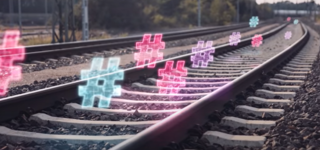
On track for the future
More and more trains are running on our tracks, pushing the rail system to its limits. In addition, there is a high number of legacy issues that further burden this system. At the same time, however, rail travel is one of the most important building blocks for the transition to a new traffic system and climate protection.
For a more attractive future rail traffic with more trains in higher quality, the rail system must be fundamentally modernized through profound, technological innovations. That is why the Digital Rail Germany sector initiative has set itself the task of creating more capacity in the rail network and thus improving quality and punctuality.
The digitization of the rail system requires new, cross-sector and cross-border partnership models:
- Whereas DB was previously a traditional customer, we are now entering into development partnerships with industry.
- Whereas DB was previously a mere user of technologies, it is now becoming an active co-developer.
- Whereas the systems were previously closed, there will be open platforms in the future.
The sector initiative takes into account both the latest technologies of the railroad sector as well as technical solutions from other industries. In addition, the sector initiative balances out historically evolved national rail systems with different technical standards as part of standardization and harmonization at the European level. That is why we are investing not only in the digitization of infrastructure, but also in the research and development of future technologies.